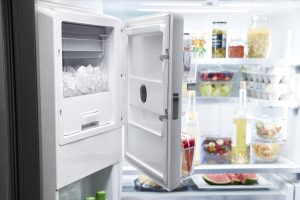1. Set the Refrigerator Temperature Manually
For the best balance of performance and energy efficiency, it’s a great idea to set the internal refrigerator temperature to between 36ºF and 38ºF. In the freezer section, this should drop to between 0ºF and 5ºF. The problem is that many refrigerators don’t allow the user to track the internal temperatures accurately. When you adjust a simple dial from 1-5, those numbers don’t have any real relevance if you want to conserve energy. Investing in a good refrigerator and freezer thermometer can help you to get better control over the internal temperatures.
2. Defrost the Refrigerator and Freezer Regularly
Certain refrigerator models have automatic defrosting features that can be a real time saver. But, if you have an older or less feature rich model, it may be necessary to defrost the appliance manually. The accumulation of ice within the refrigerator coils can cause the appliance to overwork and it’s harder for the unit to maintain consistent temperatures. Overworked systems are more likely to fail and a professional technician will be needed to make the necessary repairs. If you have a modern refrigerator, automatic defrosting is usually a standard feature.
3. Check the Rubber Door Seals
The rubber door seals are also referred to as gaskets and they prevent warm air from entering the interior of the refrigerator. This is an often overlooked component because the concept is so simple, but it’s critical for the overall performance and energy efficiency. When the internal temperature is raised it becomes increasingly harder for the appliance to keep the stored food chilled or frozen to the set temperature. This will introduce extra strain on the equipment, it will drive up the energy bills and it will shorten the lifespan of the appliance. Over time rubber gaskets can lose some of the suction properties because the refrigerator doors are opened and closed frequently. If the gaskets are loose or compromised, get them changed to protect your appliance.
4. Avoid Heat Sources
Keep the refrigerator away from sources of heat because the compressor needs to work harder if the temperature around the appliance rises. This includes kitchen appliances and direct sunlight. If you have a kitchen where sunlight shines on the refrigerator, consider drawing the blinds to create shade during the hotter parts of the day. If you’re designing a new kitchen keep the refrigerator away from the cooking areas or other heat emitting appliances.
5. Keep the Refrigerator Door Closed
Many people open their refrigerator door for long periods when they cook to reach the shelves easily. But, when the door is open the warmer external air enters the interior and the compressor must work harder as it attempts to cool the spaces. The best way to avoid this problem is to work more efficiently. Open the refrigerator or freezer door, take out everything that you need to cook, and close it again. This will maintain the performance with minimal disruption, lower the energy bills and protect the refrigerator.
If you’re still struggling with your refrigerator, you can rely on a professional home appliance technician to diagnose any underlying issues and provide a repair solution.
